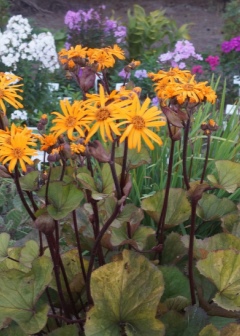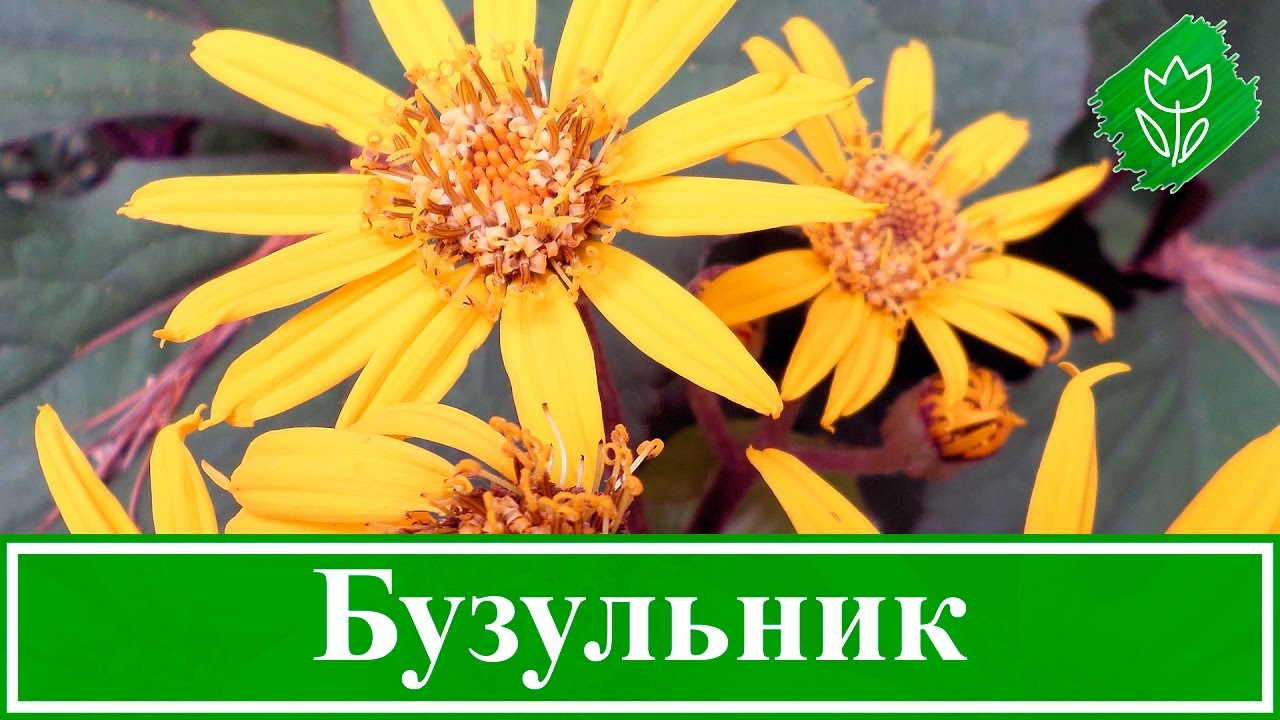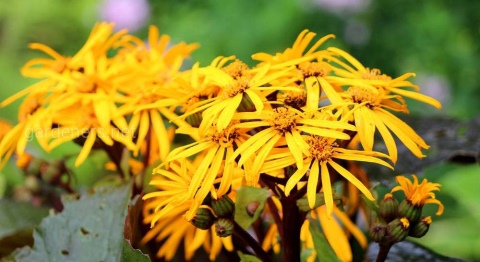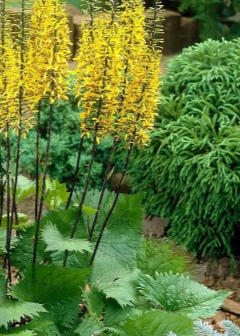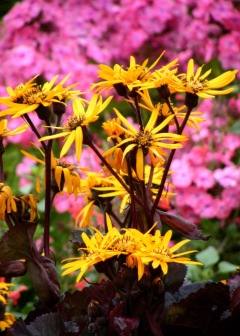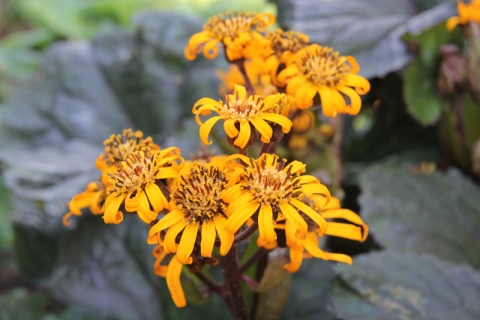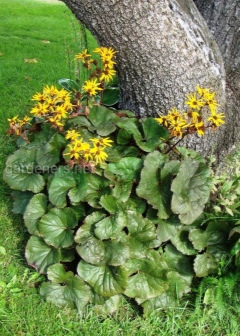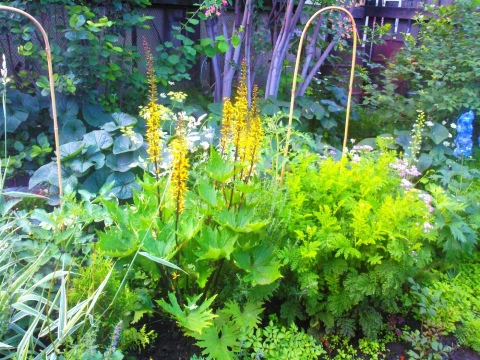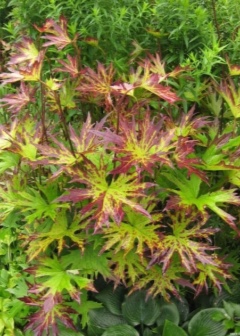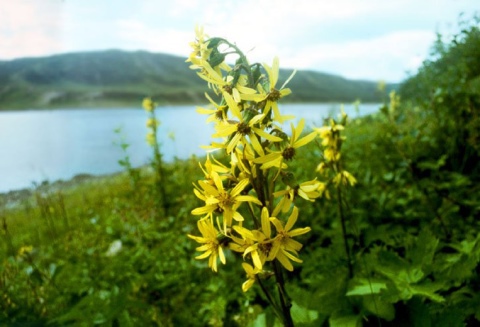Names and characteristics of species and varieties of buzulnik with a photo
Buzulnik toothed (Ligularia dentata) is a perennial rhizomatous exclusively ornamental plant with straight stems up to 120-180 cm high. Large leaves (up to 50 cm in diameter) are located on long petioles. Flower baskets up to 8 cm in diameter, yellow-brown in color, are collected in a paniculate inflorescence. The marginal flowers of the basket are ligulate, yellow or orange, the middle are tubular, yellow or brown. Blooms in August - September.
All varieties of toothed buzulnik have inflorescences of different shades of yellow, and they look very bright and elegant. Some of them are described below:
"Othello" - yellow-orange baskets and inflorescences;
"Desdemona" - bright orange inflorescences and lilac brown leaves;
"Britt Marie Crawford" - variety 1 m high. Basal leaves are dark brown above, purple below. The flowers are rich yellow;
"Orange Queen" - a low-growing variety with a height of about 0.5 cm. Flowers are rich orange color;
Osiris Fantasy is a dwarf variety, reaching no more than 0.5 m in height. The leaf plates are green from above, burgundy below.
Buzulnik Kempfer (L. kaempferi). Densely leafy plant up to 1.2 m high, serrated leaves, pubescent petioles. Baskets up to 5 cm in diameter, light yellow, collected in corymbose inflorescence.
Buzulnik Przewalski (L. przewalskii). One of the most common types of buzulnik, which is a small bush (up to 90 cm) of a beautiful spherical shape. Basal leaves are collected in bunches, stem leaves are lanceolate, on long petioles. Baskets are yellow-brown, up to 4 cm in diameter, collected in a paniculate inflorescence.
Buzulnik Przhevalsky varieties:
"The Rocket" is one of the highest cultivars of buzulnik, the height of which reaches 2 m. The leaves are dark green, in autumn they acquire a crimson color.
"Maple-leaved" - the variety got its name from the shape of the leaves, reminiscent of maple leaves. They are large, about 25 cm in diameter, dense, rough, dark green. The height of the variety is 180 cm.
"Light Fingered" - the variety has decorative openwork foliage and bright yellow flowers.
The description of the varieties of buzulnik of this species is supplemented with a photo, which can be seen below and consider the characteristic features of each specimen:
Siberian Buzulnik (Ligularia sibirica). According to its characteristics, it is a perennial short-rhizome plant with an erect stem up to 120 cm in height. The leaves are triangular-cordate, dentate along the edge, the lower ones are on long ones, the upper ones are on short petioles. The leaf blade is glabrous or pubescent on both sides. Baskets 2-3 cm in diameter in racemose inflorescences. Flowers are yellow, marginal ligulate, median tubular. Fruits are achenes with a tuft of simple hairs. Blossoms in June-July; bears fruit in July-August. Occurs in low-lying bogs, boggy meadows, coniferous-small-leaved boggy forests, overgrown peat mining, along the banks of rivers and lakes.
Buzulnik Wilson (Ligularia wilsoniana) is a tall herbaceous plant, reaching up to 1.5 m. It has a thin, straight, branched stem. The leaves are large, dense, rough, dark green. Formed at the bottom of the stem. Flowers are yellow, numerous, collected in inflorescences - baskets with a diameter of 2.5 cm. Flowering begins in July, lasts until late August or early September. This type of buzulnik is distinguished by an increased requirement for lighting; it must be planted in areas open to the sun.
Popular types and varieties of buzulnik
In the natural environment, there are about 150 different plant names. Up to 20 species have been cultivated. In our climatic conditions, several types of toothed buzulnik and Przhevalsky take root well. Let's consider the features of the most popular and beautiful varieties in more detail.
Toothed
It grows well, reaches a height of 100 - 110 cm. It is distinguished by bright jagged leaves, according to the shape of which it got its name. Inflorescences are yellow in color: from light to brown.Due to its decorative appearance, it is appreciated by gardeners. The plant is planted along a path, under a fence or in the center of a large flower bed.
The most popular subspecies of dentate ligularia are the following:
- Desdemona;
- Othello;
- Marie Crawford;
- Osiris.
The plant begins to bloom in mid-summer. Flowers fall in early autumn.
Desdemona cultivar
Magnificent in its external data, the toothed Buzulnik Desdemona, whose photo is presented below, is liked by many gardeners
Picturesque wavy leaves with a double color grow in a lush cap on the lawn, attracting attention. The bottom plate is painted purple-brown, the top dark green
The buds open in August. They have pointed yellow petals with a dark center. The height of the bush is no more than 90 cm.
This variety looks great in garden design. See how the desdemona buzulnik successfully emphasizes the spaciousness and comfort of the summer cottage (photo gallery for your attention).
Blooming Desdemona. The culture is not afraid of partial shade and grows well along the country house.
Young ligularia during the autumn flowering period.
Buzulnik in close proximity to other large flower beds.
Othello variety
A distinctive feature of Othello is its spreading leaves, reaching a size of about 40 - 50 cm. The plant looks beautiful on the shore of an artificial pool and a natural pond. The color of the leaves inherent in serrated ligularia becomes especially bright closer to autumn. Buzulnik Othello, photos of flowers of which are collected in a separate gallery below, blooms at the end of August. Flowering lasts a little over a month.
The petals of small flowers of the Othello variety have a bright yellow color.
Osiris cultivar
Buzulnik Osiris is the smallest and most charming subspecies of serrated ligularia. It is planted in a flower bed in a row of medium plants. The height of the bush reaches no more than half a meter. Osiris perfectly coexists with other perennials, for example, phlox or New Belgian asters. All summer it is dazzled with rich green leaves, and by mid-July it blooms with small lemon "stars". The flowering period is approximately 40 days.
Marie Crawford variety
The buzulnik Marie Crawford (photo of varietal plants in the garden design below) is distinguished by the original color of the leaves. They combine several shades at once: from purple to brown, from marsh to malachite. A spreading bush with large leaves grows about a meter in height. Flowers rise like a cap of fire over the leaves from August to September.
Marie Crawford in an English garden adjacent to perennial grasses, lilies, ferns and shrubs.
Types and varieties of calistegia with photos and names
A relatively small number of calistegia species are grown in the culture. The most popular ones will be described below.
Fluffy Calystegia (Calystegia pubescens)
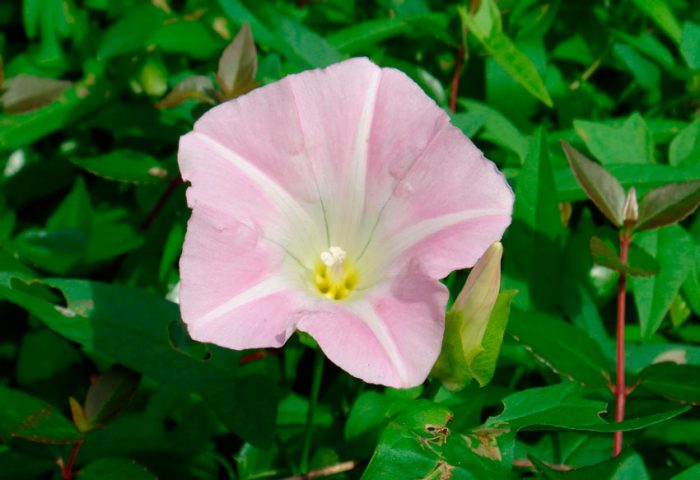
This species comes from the territory of China, its stems reach 4 meters in length. The shoots are covered with slightly elongated leathery leaf plates of a rich green color, as well as double flowers, the diameter of which reaches 4-9 centimeters. Bell-shaped flowers have white-pink petals with a dark base. Planting and caring for this terry plant is exactly the same as for a simple one. The most popular variety is the flora of captivity: the shape of the leaf plates is arrow-shaped, and on the surface there is a gentle pubescence, pink double flowers are outwardly similar to pompoms.
Calystegia pellita

The homeland of this species is the Far East and Altai. In nature, it prefers to grow on rocky slopes, dry meadows, and also in bushes, like an ordinary weed. This densely haired herbaceous perennial plant has a long cord-shaped rhizome. The shoots of such a flower can reach 0.8 meters in length. Oblong pointed leaf plates have a broad-lanceolate shape.The color of simple flowers is pink. This species has been cultivated since 1884.
Intake calystegia (Calystegia sepium)
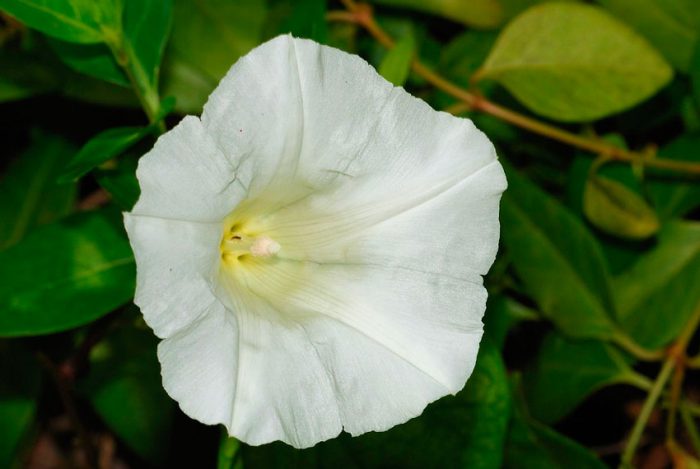
The branches of this perennial plant are about 300 centimeters long. Triangular-ovate or triangular leaf plates have a pointed apex. Simple single flowers can be painted in pale pink or white. This species is the very weed that simply cannot be completely "uprooted" from your garden or garden. It can also grow incredibly quickly.
Japanese fluff (Calystegia japonica), or new ivy (Calystegia hederifolia)
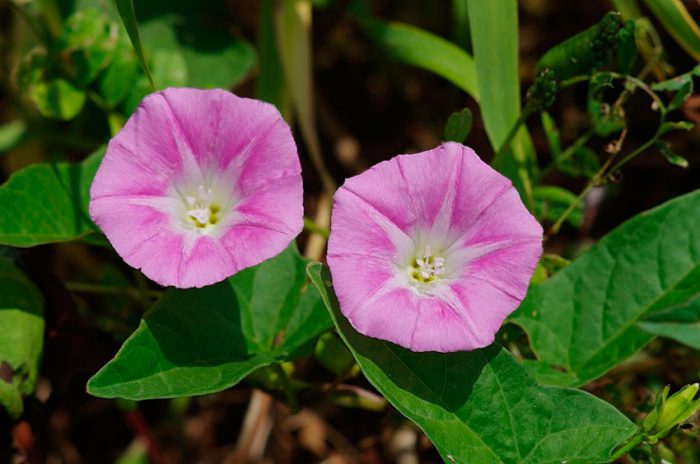
This type is terry. The length of its shoots varies from 1.5 to 2.5 meters. Small leaf plates are alternately arranged. The diameter of the double flowers is about 9 centimeters, and their color is pale pink.
Kalistegia Multiplex is a hybrid hop calistegia variety that is quite popular among gardeners. The length of the shoots of this plant is about 350 centimeters. Its double flowers reach 10 centimeters in diameter, they have a pink-pearl color that shimmers in sunlight. This variety is highly decorative, and it is able to compete even with excellent clematis.
Buzulnik after flowering
How and when to collect buzulnik seeds.
If you want to collect buzulnik seeds, tie a few inflorescences with gauze at the end of flowering so that the seeds do not spill to the ground after ripening, and cut off the rest of the flower stalks. This measure stimulates the growth of leaves and an increase in their size, and also prevents spontaneous self-seeding. In autumn, when the leaves begin to change color, the buzulnik becomes a real decoration of the garden - until mid-October. When the inflorescences in gauze bags are completely dry, cut them off, bring them into the house, shake out the seeds from them, peel off the remnants of flowers and wind. If you want to sow buzulnik before winter, just spread the seeds on paper and wait for the time to sow. If you are sowing seeds in the spring, dry them on paper and put them in a box or paper bag.
Buzulnik in winter.
With the onset of the first frosts, cut off the ground part of the bushes at the root and, just in case, mulch the site - although the buzulnik is a winter-hardy plant, severe unexpected frosts in a snowless winter can harm even such a cold-resistant plant.
History
The homeland of the buzulnik is Southwestern China, it is there that there are most wild species. In Russia, on marshy meadows, near streams and lakes, Siberian Buzulnik grows - a tall plant with lush yellow-brown brushes.
The Latin name of the plant is ligularia, from the Latin ligula - tongue. The inflorescence-basket consists of tightly packed petals with rounded edges, which are rolled up like small tongues.
Serious selection began at the beginning of the 20th century. New varieties appear every year, and recently varieties with leaves of different shapes and colors have been obtained. The Japanese have long preferred leaves to flowers and cultivated unique green gardens.
How to grow a buzulnik in your garden?
In the wild, Buzulnik mainly grows in Asia and China, and can also be found in southern Europe. This flower is very fond of a humid and warm climate. Planting ligularia in the garden is popular with lovers of landscape design, especially since any gardener can take care of it.
general description
At a relatively cool temperature, flowering can last only a month and vice versa. After the buzulnik has bloomed, a fruit with seeds is formed, which has an oblong shape.
Florists are very fond of using the inflorescences of this plant in their dry and fresh bouquets, because freshly cut flowers keep their living beauty for about 10 days. Buzulnik is usually the basis of the composition and is complemented by other colors, for example, as in the photo.
Buzulnik toothed - a species for cultivation in our latitudes
Consider the most popular varieties of this species, which are most often found in our gardens. These are Othello, Desdemona, and Przewalski's buzulnik, who, by the way, come from China and Japan.
- Buzulnik Desdemona (pictured) has leaves of a lilac-brown hue, blooms with orange or fiery orange flowers, starting from late August to mid-October. The inflorescences reach 10-13 centimeters in diameter, and the leaves are about 40 centimeters. The stem is one meter high.
- Buzulnik Othello (pictured) reaches a height of 90 centimeters, has very large purple leaves, the average size of which is about 50 centimeters. The plant of this variety blooms with beautiful large flowers, reaching a diameter of 13 centimeters. In the garden, the inflorescences stand out very much and look harmoniously among the surrounding greenery, attracting the eye with their tangerine or orange color. Othello usually begins to bloom with the onset of September and blooms until the first October frost.
- Buzulnik Przewalski (pictured) differs from its counterparts in beautiful, exotic flowers in the form of candles. He is one of the most common representatives of his species in a garden or park. Typically, the height of the stem reaches 1.5 meters, and sometimes 2 meters. The Przewalski variety begins to bloom with yellow flowers from mid-June and ends flowering at the end of August. It is unpretentious and does not require special care. With this view, you can decorate a fence, as well as, for example, hide a compost pit.
Planting and caring for a perennial buzulnik
The plant can grow in any soil, but it is desirable that the soil is moist and not depleted. If the site where the planting will be carried out is clay, then humus must first be introduced into the pit. Buzulnik can be propagated in two ways - with the help of seeds or by dividing the bush. It is possible to transplant and propagate the bush by dividing during the spring - autumn period. The life of a plant in one place is 10-15 years, it all depends on the care and feeding.
The distance between the bushes of the buzulnik should be at least 1 meter so that the plants do not clog each other. The best breeding season is spring, since the transplanted bush will have time to fully recover before winter, and in the next season it will bloom beautifully.
Caring for these wonderful plants is very simple and easy. The main thing to remember is that they love shaded places, since direct, scorching sunlight can lead to the fact that in the heat, large leaves will have an unpresentable withering appearance. In this case, there will be only one care for it - additional watering.
The main thing that the buzulnik needs is a large amount of moisture, therefore, planting this plant is usually carried out in a damp place, which will facilitate maintenance, otherwise water the flower regularly abundantly, especially in dry summers. If the air is very dry, then also spray the leaves when watering, the evaporating moisture will create a pleasant comfortable humid microclimate for the leaves.
Buzulnik pruning and pest control
With the onset of the first frost, prepare the plant for winter. Cut off the entire aerial part to the very root, this will allow the flower to winter better.
As a top dressing, you can use both mineral and organic fertilizers, for example, humus. This is especially necessary when the plant is planted in the ground. The main enemy of the buzulnik are snails and slugs, which eat up the leaves, so to protect against them, treat the bush with superphosphate.
Caring for calistegia in the garden
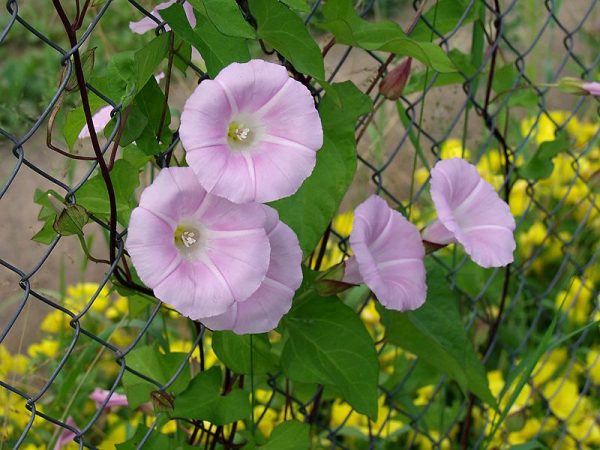
Kalistegiya is distinguished by its unpretentiousness, frost resistance and drought resistance. Caring for it is extremely simple, all that needs to be done is to moderately water the plant and loosen the soil superficially with a pitchfork to a depth of no more than 20-30 mm. During the rainy season, the flower can do without watering, but in dry season it needs them.
Such a fast-growing plant needs systematic feeding; for this, a complex mineral fertilizer is used (per 1 square meter 1 tbsp. L. Substance).
Throughout the growing season, Kalistegia needs regular pruning and cutting off flowers that have begun to fade.
Diseases and pests

The grown new can be infected with various diseases, and pests sometimes settle on it. Regular stagnation of water in the soil can cause the development of one of the rot or powdery mildew. The affected specimen must be sprayed with a fungicide solution (for example, Fitosporin-M), and also for a while it must be left without watering. Slugs love the juicy leaves and flowers of the plant. To get rid of such pests, it is recommended to spray the vines and the surface of the soil near them with Thunderstorm. If there is a long dry and sultry weather, then spider mites can settle on a new one. They get rid of them with acaricides, for example, Aktara or Aktellik.
After flowering
All types of calistegia are highly winter-hardy, except for fluffy calistegia. However, if forecasters predict a frosty winter with little snow, then the area with plants will need to be covered with peat, dried foliage or sphagnum. Do not forget to pre-cut any dried lashes.
Calistegia. Growing.
Caring for the buzulnik in the garden after planting
Buzulnik is that unpretentious perennial, about which one can say “planted and forgot”. Even in the absence of care, this culture will grow and feel great on the site. But then it will lose its neat, well-groomed appearance and at the same time its decorativeness. To prevent the plant from looking like a weed, you must follow the rules for caring for it after planting. Moreover, they are very simple and will not burden even a lazy gardener.


Location. Growing a buzulnik in one place without transplanting is possible for a very long time (up to 10-15 years). Favorable conditions for growing a plant are a damp area or abundant watering, although with regular irrigation it feels good both in the sun and in partial shade. In dry hot weather, large leaves often lose their turgor and droop, only with the onset of the evening coolness take their natural appearance. In this case, they are shaded from the scorching sun from the south side.
The soil. Prefers nutrient-rich soil, but grows well on heavy, clayey soil, tolerates temporary flooding.
Top dressing. As already noted, in one place this culture can grow for a long time, therefore, periodic feeding is included in caring for the buzulnik. It is advisable to add humus or complex complete mineral fertilizers to the soil when planting. With depleted soil, peat and compost can be added to the soil. Once planted, they are used as mulch. For abundant flowering annually, before August, the plant is fed 2 times a month with full mineral fertilizer or liquid fertilizer (mullein infusion 1: 10).


Watering. In the hot dry summer period, the buzulnik in the garden needs regular and abundant watering. This work must be done at least 1 time a week. In dry summers, when there is very little rainfall and in intense heat - 2 - 3 times a week. After watering, you should loosen the soil around the bush to break up hard soil, remove weeds, and avoid stagnant moisture and root rot. Mulching with peat or humus is of great benefit.
Transfer. Plants are usually transplanted in spring, in early May, or in autumn, in September - October. If necessary, you can replant in the summer, cutting off the ground part. This procedure is very beneficial for the plant, as it rejuvenates and maintains a neat appearance.
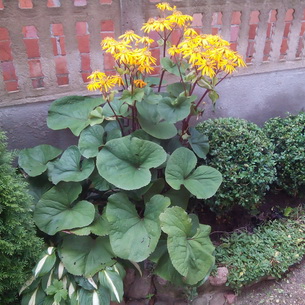
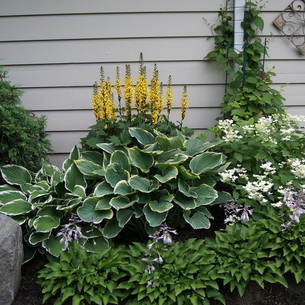
Pruning and garter. Pruning must be done in order to preserve the decorative appearance of the ligularia. It is necessary to immediately remove dried flowers after flowering.This promotes the growth of the plant and the appearance of numerous leaves.

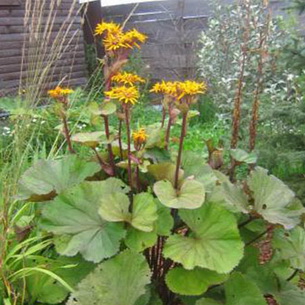
Frost resistance and wintering. Buzulnik is a hardy, cold-resistant herb for open ground, which is not damaged by frost and spring frosts. In spring it grows only in the first ten days of May.
In autumn, after flowering, the aboveground part of the plant is cut to the soil level. For the winter, cover the ligularia with a layer of mulch. A layer of snow can be placed on top.
Diseases. The plant is rarely affected by diseases or pests. Sometimes the cause of his illness is slugs, snails and spider mites. With excess moisture, fungal infections and powdery mildew are possible.
If slugs are found, they must be removed from the bush and destroyed. To prevent their reappearance, sprinkle superphosphate granules near the bushes.
To combat powdery mildew and other fungal diseases, treatment with a solution of potassium permanganate or colloidal sulfur is effective.
Below is a selection of photos of a buzulnik plant, which shows how it is grown on the site:
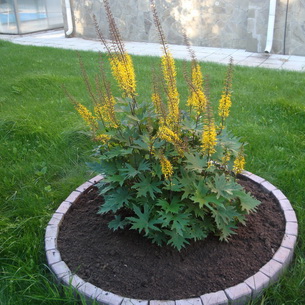
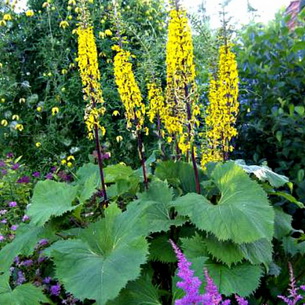
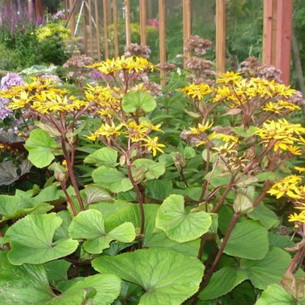
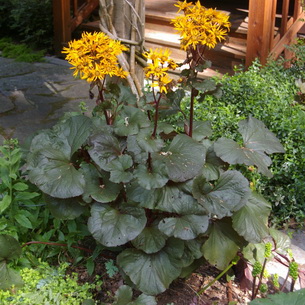
How to care for a buzulnik
Soil care
In spring, soil care consists in loosening the area around the buzulnik and mulching the soil. In the summer, these procedures help to retain the moisture of the earth for a longer time.
Required temperature for growth
Ligularia cannot stand hot, dry weather. This negatively affects her growth and appearance. But she easily tolerates a drop in air temperature. For germination of seeds of a newly planted plant, a sufficiently comfortable temperature is + 15-20C.
Watering
Watering ligularia should be regular - every 3-4 days. Due to the fact that the root of the flower is long, located deep in the ground, watering should also be abundant. At the slightest drying out of the soil, the leaves of the plant wither, and growth slows down. In hot summer weather, in addition to the main watering, the flower should be sprayed in the morning or evening, when the sun is not as active as during the day.
Transfer
Buzulnik can grow on one site for at least 10 years. However, in order to preserve the decorative qualities of the plant, it is recommended to replant it once every 5 years in spring or autumn. If such a need arose in the summer, the entire aerial part of the flower is cut off. They must be transplanted into a hole filled with water and all the time they monitor the level of soil moisture, since the plant loses a lot of strength and it can take root for a long time.
Top dressing
Provided that the soil is properly fertilized during planting, the plant is not fed for the first year, but they begin to do this from the second year during spring loosening. With a poor composition of the soil, the plant is fed during the period of active growth, production of seeds and flowers. In the summer, complex fertilizers are used, and after the snow melts, formulations with nitrogen are introduced. Twice a season, you can feed the soil with humus. If there is a difference between night and day temperatures, it is better to transfer feeding to a more favorable period.
Reproduction
Ligularia is propagated in two ways:
- seeds
- division
- seedling method
In the latter case, the seeds are placed in a nutritious soil in the spring, after which they are regularly moistened. When the seedlings get stronger, they are transplanted into open ground. After 3-4 years, the plants will bloom. Reproduction by division is simple: when young leaves appear from the ground, part of the bush is separated with a shovel and transplanted. Both the delenki and the bush itself are covered with earth and watered abundantly. This breeding method is best done in the spring.
Winter preparation and winter care
If the flower grows in a climate with harsh winters, it is worth removing the ground part of the plant before wintering, and mulching the soil. This will help him to spend the winter most comfortably, especially if there is very little snow. In regions with severe frosts and winters with little snow, it is recommended to cover a bed with a buzulnik for the winter to prevent the seeds from freezing.
Among other things, the plant needs to be pruned periodically. This is done in order to preserve the decorative effect of the shrub. Pruning involves removing faded baskets, dry leaves and broken shoots. In the fall, the peduncles are removed.
Sowing seeds
Buzulnik can be propagated by dividing the bush and seeds. Seeds are sown in the spring in open ground, while they are buried only 1 centimeter. Before seedlings appear, it is necessary to ensure that the soil is always moist. Seemed seedlings must be shaded from direct sunlight from lunch to evening. However, it is recommended to sow in November or December before winter, and use recently collected seeds for this, during the winter they will be able to undergo natural stratification. For seedlings, seeds are sown in January or March (depending on the flowering time of the variety or species), they are transplanted into open soil in May, when there is no threat of frost. In the event that the seeds have time to ripen directly on the bush and fall on the soil surface, then self-seeding occurs. A plant grown from a seed begins to bloom only at the age of 4 or 5 years.
Reproduction of buzulnik
There are two ways to propagate the buzulnik: by seeds or by dividing the bush. I would like to immediately warn you that the process of seed reproduction is very laborious, unreliable, long:
- seeds do not always ripen;
- varieties with purple leaves differ poorly;
- in addition, it is not known whether the seedlings will retain varietal characteristics (if the seeds are collected from a hybrid plant, it is already clear here: there will be no varietal characteristics);
- we will see flowering plants in the fifth year;
- Buzulnik is able to reproduce by self-seeding, in the spring, small seedlings appear near the mother bush, which, if desired, can be used.
Growing buzulnik ligularia from seeds photo seedlings
If you think you can handle it, then go for it:
- You need to collect the seeds, dry them thoroughly.
- Embed the seeds into the soil 1 cm deep in the fall, so that the planting material undergoes natural stratification. Wait for a persistent cold snap so that the seeds do not germinate until spring. Pour generously, because many of them will not rise. It is imperative to cover the plot with sowing for the winter - to protect the seeds from freezing.
- In the spring, remove the shelter, then wait for the first shoots. The sprouts that have appeared must be shaded, opening only in the morning and in the evening.
- It is necessary to thin out the seedlings twice, with an interval of two weeks. Next, take care of the usual seedlings.
- It is advisable to transplant to a permanent place in the fall, after the extreme heat recession, but so that there is a month or two in reserve until the seedling is completely rooted before wintering.
- The first 3-4 years, young plants will delight us with juicy foliage, usually bloom in the fifth year.
To grow seedlings on a windowsill:
- Place the soaked seeds in a damp cloth and bag in the refrigerator around January.
- In early March, plant them in a moist substrate.
- Cover containers with plastic or glass.
- When shoots appear, remove the shelter.
- Take care in the usual way: water, fertilize once every two weeks.
- It is better not to make a pick, but to break through the extra seedlings, choosing the strongest plants.
- Having hardened the seedlings before planting, we move them to a permanent place around August, when there will be no heat anymore, so that the plants have time to root before wintering.
Reproduction by dividing the bush
Reproduction of buzulnik by dividing the bush photo
Basically, amateurs do not have so much patience or time, and why, if the buzulnik reproduces perfectly by dividing the bush. In the spring, when the first leaves peck out of the ground, we simply cut off a part of the bush with a shovel and dig it out. The rest of the plant continues to live in its place, quickly healing the wound with nutritious soil, which we will carefully add to the vacant place.
- The extracted planting material must be carefully washed, cleaned, and can be divided into several divisions so that each one has buds and rhizomes.
- To prevent rotting, treat the sections with a strong solution of potassium permanganate, then safely plant them in a permanent place.
- Within a year, the bush will bloom in all its glory.
Buzulnik can grow in one place for many years, however, it is advisable to divide the bush every five years, otherwise the roots will begin to stick out. Since such a procedure is useful for the plant, then you can easily not only buy planting material in specialized stores, but also take the variety you like from your neighbor.
When buying in spontaneous markets, there is a risk that you will buy a completely different plant that you wanted, so to speak "pig in a poke".
In nurseries or flower shops they will tell you everything about the variety of the plant, the age of the seedling. In any case, before planting, carefully examine the seedling so that it is healthy, without signs of disease.
Buzulnik matches very nicely with hosts of different colors
It is important to know the planting site in advance in order to choose the right variety, because some of them are very tall, large, you need to calculate the dimensions correctly, so to speak. Buzulnik will grow on any soil, but prefers fertile, moist soils. His favorite places:
His favorite places:
- the shade of fruit trees;
- partial shade from the fence;
- shadow from the house;
- coolness near ponds, fountains;
- if you have to grow in the sun, it requires abundant and regular watering, otherwise it will lose its decorative appeal.
Features of Buzulnik
Buzulnik is a powerful herbaceous perennial of the Asteraceae family (Compositae), decorative from spring to late autumn. Its leaves, pleasing to the eye in shape and color, are striking in their size (up to 60 centimeters in length and in diameter!). Leaves (usually on long petioles, deeply elliptic at the base) form a basal rosette.
The shape of the leaves, depending on the species, is heart-shaped, reniform, triangular, palm-shaped, broadly oval (often with teeth along the edge), finger-split.
The color of the leaves is also varied: green, dark green, greenish-purple, red-brown. Plants with a double leaf color look original, for example, the top is dark green with a purple tint, and the bottom is intensely purple. In some varieties, the petioles and veins of leaves are painted in purple, red-brown and lilac tones.
Buzulniki bloom for a long time, abundantly and "sunny". Like chamomiles, asters and other plants of the Compositae family, nondescript tubular and bright marginal (reed) flowers in buzulniks are collected in inflorescences-baskets (up to 10 centimeters in diameter).
Baskets, in turn, form more complex spike-like, racemose, corymbose or paniculate inflorescences, usually yellow or orange in color (sometimes the marginal flowers in inflorescences-baskets are reddish or whitish, depending on the species). In a brush, panicle or ear, the flowers bloom from bottom to top, while the inflorescence remains decorative until the opening of the very last flower.


